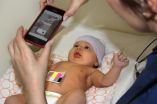(Press-News.org) Learning is easier when it only requires nerve cells to rearrange existing patterns of activity than when the nerve cells have to generate new patterns, a study of monkeys has found. The scientists explored the brain's capacity to learn through recordings of electrical activity of brain cell networks. The study was partly funded by the National Institutes of Health.
"We looked into the brain and may have seen why it's so hard to think outside the box," said Aaron Batista, Ph.D., an assistant professor at the University of Pittsburgh and a senior author of the study published in Nature, with Byron Yu, Ph.D., assistant professor at Carnegie Mellon University, Pittsburgh.
The human brain contains nearly 86 billion neurons, which communicate through intricate networks of connections. Understanding how they work together during learning can be challenging. Dr. Batista and his colleagues combined two innovative technologies, brain-computer interfaces and machine learning, to study patterns of activity among neurons in monkey brains as the animals learned to use their thoughts to move a computer cursor.
"This is a fundamental advance in understanding the neurobiological patterns that underlie the learning process," said Theresa Cruz, Ph.D., a program official at the National Center for Medical Rehabilitations Research at NIH's Eunice Kennedy Shriver National Institute of Child Health and Human Development (NICHD). "The findings may eventually lead to new treatments for stroke as well as other neurological disorders."
Brain-computer interfaces seek to turn thoughts into action. With small surgically implanted electrodes, researchers can simultaneously monitor the electrical activity of hundreds of neurons. A computer converts the signals into commands to move an external device, such as a robotic arm or a computer cursor. Brain-computer interfaces are being developed to help paralyzed patients as well as to study the function of healthy brains.
"This evolving technology is a powerful tool for brain research," said Daofen Chen, Ph.D., a program director at the National Institute of Neurological Disorders and Stroke (NINDS), part of NIH. "It helps scientists study the dynamics of brain circuits that may explain the neural basis of learning."
In this study, the research team used brain-computer interfaces in two animals to examine learning in the motor cortex, a part of the brain that controls movement. The firing patterns of the neurons they recorded were used to control a computer cursor. As the animals learned to move the cursor to a designated spot on the monitor, the computer used machine learning to map brain cell activity to cursor movement. Machine learning is a method of programming a computer to learn and constantly adjust its commands based on previous data or experience. In this case, it created a feedback loop between the animal and the computer, which improved the animal's ability to use its thoughts to move the cursor.
"Just as Netflix uses machine learning to predict the movies we'd like to watch, we used it to characterize the activity patterns that the brain produced during learning," said Dr. Yu.
At first, the scientists noticed that the ensemble of neurons recorded in each animal had a small set of natural, or favored, firing patterns that were used to move the cursor, which they called the "intrinsic manifold." After determining the intrinsic manifold, the team reprogrammed the map between neural activity and cursor movement. For instance, if a firing pattern originally caused the cursor to move to the top of the screen, then the interface would move the cursor to the bottom. The team then observed whether the animals could learn to generate the appropriate neural activity patterns to compensate for the changes.
"It's as if we turned a computer mouse upside down in a person's hand and asked him to click on an icon, except the mouse is entirely within the subject's brain," said Patrick Sadtler, a Ph.D. candidate at the University of Pittsburgh, who is the lead author of the study.
The scientists discovered that the monkeys easily relearned how to move the cursor if they could use patterns within the intrinsic manifold in new ways. In contrast, learning was more difficult when the interface required patterns of neural activity that were outside of the intrinsic manifold.
"It appears that the brain sets constraints on the speed with which we learn new things. Characterizing those constraints might enable us to predict which skills will be quicker to learn, and which might take longer," said Dr. Batista. He and his colleagues speculated that, for humans, thinking outside the box requires more difficult changes in neural activity.
INFORMATION:
This work was supported by grants from the NICHD (HD071686), NINDS (NS065065, NS076405), National Science Foundation (DGE-0549352), and the Burroughs Welcome Fund.
References:
Sadtler et al. "Neural constraints on learning," Nature, August 28, 2014. DOI: 10.1038/nature13665
For more information on brain research, visit:
http://www.ninds.nih.gov/
For more information on child health and development, visit:
http://www.nichd.nih.gov/Pages/index.aspx
The NINDS is the nation's leading funder of research on the brain and nervous system. The mission of NINDS is to seek fundamental knowledge about the brain and nervous system and to use that knowledge to reduce the burden of neurological disease.
The Eunice Kennedy Shriver National Institute of Child Health and Human Development (NICHD) sponsors research on development, before and after birth; maternal, child, and family health; reproductive biology and population issues; and medical rehabilitation.
About the National Institutes of Health (NIH): NIH, the nation's medical research agency, includes 27 Institutes and Centers and is a component of the U.S. Department of Health and Human Services. NIH is the primary federal agency conducting and supporting basic, clinical, and translational medical research, and is investigating the causes, treatments, and cures for both common and rare diseases. For more information about NIH and its programs, visit http://www.nih.gov.
Scientists plug into a learning brain
NIH-funded study provides a neural explanation for why some skills are easier to learn than others
2014-08-27
ELSE PRESS RELEASES FROM THIS DATE:
Pitt and Carnegie Mellon engineers discover why learning can be difficult
2014-08-27
PITTSBURGH—Learning a new skill is easier when it is related to ability that we already possess. For example, a trained pianist might learn a new melody more easily than learning how to hit a tennis serve.
Neural engineers from the Center for the Neural Basis of Cognition (CNBC)—a joint program between the University of Pittsburgh and Carnegie Mellon University—have discovered a fundamental constraint in the brain that may explain why this happens. Published as the cover story in the Aug. 28, 2014, issue of Nature, they found for the first time that there are constraints ...
Kessler Foundation scientists study impact of cultural diversity in brain injury research
2014-08-27
West Orange, NJ. August 27, 2014. Kessler Foundation scientists examined the implications for cultural diversity and cultural competence in brain injury research and rehabilitation. The article by Anthony Lequerica, PhD, and Denise Krch, PhD: Issues of cultural diversity in acquired brain injury (ABI) rehabilitation (doi:10.3233/NRE-141079) was published by Neurorehabilitation. Drs. Lequerica and Krch are research scientists in Traumatic Brain Injury (TBI) Research at Kessler Foundation and co-investigators for the Northern New Jersey TBI Model System.
Cultural sensitivity ...
New smartphone app can detect newborn jaundice in minutes
2014-08-27
Newborn jaundice: It's one of the last things a parent wants to deal with, but it's unfortunately a common condition in babies less than a week old.
Skin that turns yellow can be a sure sign that a newborn is jaundiced and isn't adequately eliminating the chemical bilirubin. But that discoloration is sometimes hard to see, and severe jaundice left untreated can harm a baby.
University of Washington engineers and physicians have developed a smartphone application that checks for jaundice in newborns and can deliver results to parents and pediatricians within minutes. ...
Parents, listen next time your baby babbles
2014-08-27
Pay attention, mom and dad, especially when your infant looks at you and babbles.
Parents may not understand a baby's prattling, but by listening and responding, they let their infants know they can communicate which leads to children forming complex sounds and using language more quickly.
That's according to a new study by the University of Iowa and Indiana University that found how parents respond to their children's babbling can actually shape the way infants communicate and use vocalizations.
The findings challenge the belief that human communication is innate ...
Lifetime of fitness: A fountain of youth for bone and joint health?
2014-08-27
ROSEMONT, Ill.—Being physically active may significantly improve musculoskeletal and overall health, and minimize or delay the effects of aging, according to a review of the latest research on senior athletes (ages 65 and up) appearing in the September issue of the Journal of the American Academy of Orthopaedic Surgeons (JAAOS).
It long has been assumed that aging causes an inevitable deterioration of the body and its ability to function, as well as increased rates of related injuries such as sprains, strains and fractures; diseases, such as obesity and diabetes; and ...
Educated consumers more likely to use potentially unreliable online healthcare information
2014-08-27
The last time you experienced worrisome medical symptoms, did you look for advice online before consulting a health-care professional? If so, you're not alone. Consumers are increasingly turning to forums, video-sharing sites, and peer support groups to gather anecdotal information and advice, which may distract them from more reliable and trustworthy sources. New research to be presented at the HFES 2014 Annual Meeting in Chicago studies the characteristics of consumers who use the Internet to collect health-care information.
"Age, educational levels, and health status ...
Southwest may face 'megadrought' this century
2014-08-27
Due to global warming, scientists say, the chances of the southwestern United States experiencing a decade long drought is at least 50 percent, and the chances of a "megadrought" – one that lasts over 30 years – ranges from 20 to 50 percent over the next century.
The study by Cornell University, University of Arizona and U.S. Geological Survey researchers will be published in a forthcoming issue of the American Meteorological Society's Journal of Climate.
"For the southwestern U.S., I'm not optimistic about avoiding real megadroughts," said Toby Ault, Cornell assistant ...
Scientist uncovers red planet's climate history in unique meteorite
2014-08-27
TALLAHASSEE, Fla. — Was Mars — now a cold, dry place — once a warm, wet planet that sustained life? And if so, how long has it been cold and dry?
Research underway at the National High Magnetic Field Laboratory may one day answer those questions — and perhaps even help pave the way for future colonization of the Red Planet. By analyzing the chemical clues locked inside an ancient Martian meteorite known as Black Beauty, Florida State University Professor Munir Humayun and an international research team are revealing the story of Mars' ancient, and sometimes startling, ...
MU researchers develop more accurate Twitter analysis tools
2014-08-27
COLUMBIA, Mo. – "Trending" topics on the social media platform Twitter show the quantity of tweets associated with a specific event. However, trends only show the highest volume keywords and hashtags, and may not give qualitative information about the tweets themselves. Now, using data associated with the Super Bowl and World Series, researchers at the University of Missouri have developed and validated a software program that analyzes event-based tweets and measures the context of tweets rather than just the quantity. The program will help Twitter analysts gain better ...
Marijuana compound may offer treatment for Alzheimer's disease
2014-08-27
Tampa, FL (Aug. 26, 2014) -- Extremely low levels of the compound in marijuana known as delta-9-tetrahydrocannabinol, or THC, may slow or halt the progression of Alzheimer's disease, a recent study from neuroscientists at the University of South Florida shows.
Findings from the experiments, using a cellular model of Alzheimer's disease, were reported online in the Journal of Alzheimer's Disease.
Researchers from the USF Health Byrd Alzheimer's Institute showed that extremely low doses of THC reduce the production of amyloid beta, found in a soluble form in most aging ...
LAST 30 PRESS RELEASES:
Scientists boost cell "powerhouses" to burn more calories
Automatic label checking: The missing step in making reliable medical AI
Low daily alcohol intake linked to 50% heightened mouth cancer risk in India
American Meteorological Society announces Rick Spinrad as 2026 President-Elect
Biomass-based carbon capture spotlighted in newly released global climate webinar recording
Illuminating invisible nano pollutants: advanced bioimaging tracks the full journey of emerging nanoscale contaminants in living systems
How does age affect recovery from spinal cord injury?
Novel AI tool offers prognosis for patients with head and neck cancer
Fathers’ microplastic exposure tied to their children’s metabolic problems
Research validates laboratory model for studying high-grade serous ovarian cancer
SIR 2026 delivers transformative breakthroughs in minimally invasive medicine to improve patient care
Stem Cell Reports most downloaded papers of 2025 highlight the breadth and impact of stem cell research
Oxford-led study estimates NHS spends around 3% of its primary and secondary care budget on the health impacts of heat and cold in England
A researcher’s long quest leads to a smart composite breakthrough
Urban wild bees act as “microbial sensors” of city health.
New study finds where you live affects recovery after a hip fracture
Forecasting the impact of fully automated vehicle adoption on US road traffic injuries
Alcohol-related hospitalizations from 2016 to 2022
Semaglutide and hospitalizations in patients with obesity and established cardiovascular disease
Researchers ‘listen in’ to embryo-mother interactions during implantation using a culture system replicating the womb lining
How changing your diet could help save the world
How to make AI truly scalable and reliable for real-time traffic assignment?
Beyond fragmented markets: A new framework for efficient and stable ride-pooling
Can shape priors make road perception more reliable for autonomous driving?
AI tracks nearly 100 years of aging research, revealing key trends and gaps
Innovative techniques enable Italy’s first imaging of individual trapped atoms
KIER successfully develops Korea-made “calibration thermoelectric module” for measuring thermoelectric device performance
Diversifying US Midwest farming for stability and resilience
Emphasizing immigrants’ deservingness shifts attitudes
Japanese eels, climate change, and river temperature
[Press-News.org] Scientists plug into a learning brainNIH-funded study provides a neural explanation for why some skills are easier to learn than others





